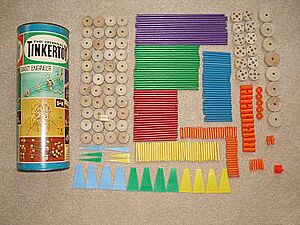Tinkertoy facts for kids
The Tinkertoy Construction Set is a classic toy that lets children build amazing things. It's a construction set made of wooden sticks and spools. Charles H. Pajeau created Tinkertoy in 1914. He started the Toy Tinker Company in Evanston, Illinois, to make them.
Pajeau was a stonemason. He got the idea for the toy after watching children play with sticks and empty spools of thread. He teamed up with Robert Pettit and Gordon Tinker to sell a toy that would help kids use their imaginations. After a slow start, over a million sets were sold!
The main part of a Tinkertoy set is a wooden spool. It's about two inches (5 cm) wide. This spool has holes drilled every 45 degrees around its edge and one through its center. The holes around the edge don't go all the way through. The sets were designed to be based on Pythagorean shapes, like right triangles, using sticks of different lengths.
Tinkertoys were first shown to the public in Chicago. Displays included model Ferris wheels built with the toys. People have used Tinkertoys to create complex machines. For example, Danny Hillis built a tic-tac-toe-playing computer with them. This computer is now in the Computer History Museum in Mountain View, California. A robot was also built using Tinkertoys at Cornell University in 1998.
The Unique Packaging
One cool thing about Tinkertoy is its packaging. The toys first came in mailing tubes. This design helped lower shipping costs. Early tubes even had a space for a postage stamp and an address label!
To help people tell the sets apart, they came in different sized tubes. Each set also had a number (like 116 or 136) and a name (like "major" or "junior"). Every set included a colorful "how-to" guide with building ideas. In the 1950s, color was added to the toys themselves. The wooden sticks started appearing in red, green, blue, and yellow.
The main factory for Tinkertoys was a large, four-story building. It was located at 2012 Ridge Avenue in Evanston, Illinois.
In 1998, Tinkertoys were honored by being added to the National Toy Hall of Fame. This museum is located at The Strong in Rochester, New York.
Today, Hasbro owns the Tinkertoy brand. They still make both plastic and classic wooden Tinkertoy sets and parts.
What's in a Standard Tinkertoy Set?
Besides the spools, a typical Tinkertoy set includes several other parts:
- Wheels: These are thinner than spools but wider. Their center holes fit snugly onto sticks.
- Caps: These small, cylinder-shaped pieces were first made of wood, then plastic. They have one hole that fits tightly onto the rods.
- Couplings: These are small cylinders, about 2 inches long. They have tight-fitting holes at each end and a loose hole through the middle.
- Pulleys: These look just like spools, but their center holes are loose, allowing them to spin freely.
- "Part W": This part is similar to a spool but has holes 90 degrees apart. It has loose center holes and four tight holes parallel to the center. This design helps create spinning parts and gear-like structures.
- Short pointed sticks: These are usually red.
- Flags: Often called "fan blades," these are typically green plastic.
- Other small parts: Various other tiny pieces are included.
Spools and pulleys have one groove around their outside. "Part W" has two parallel grooves.
The Sticks (Rods)
The sticks, also called "rods," have slots on each end. These slots help the sticks fit into holes and allow thin cards, flags, or strings to be inserted. The sticks are color-coded by size. In sets from the 1960s, the colors from shortest to longest were: orange, yellow, blue, red, green, and violet.
Each longer rod is about 1.4 times the length of the next smaller one. This special sizing means that two sticks of the same size can combine with one stick of the next size up and three spools to form a special isosceles right triangle (a triangle with two equal sides and a 90-degree angle).
Before 1992, Tinkertoy sticks were about 0.25 inches wide. Early sets had natural wood sticks. Colored sticks became popular in the late 1950s. For example, orange sticks are about 1.25 inches long, and purple sticks are about 10.85 inches long. Spools are about 1.35 inches wide, with holes about 0.30 inches deep.
Most larger sets also include a driveshaft. This is an unfinished wooden rod, longer than a green stick but shorter than a violet one. It usually comes with a small plastic crank to turn it.
The Ultra Construction Set also has connectors. These are small plastic cylinders with a slot at each end and a slotted hole through the middle.
Some Tinkertoy sets even came with battery-powered electric motors. These sets often included a wooden "double pulley." This pulley had a tight-fitting center hole and two different-sized grooved rims. This allowed different parts to move at different speeds.


